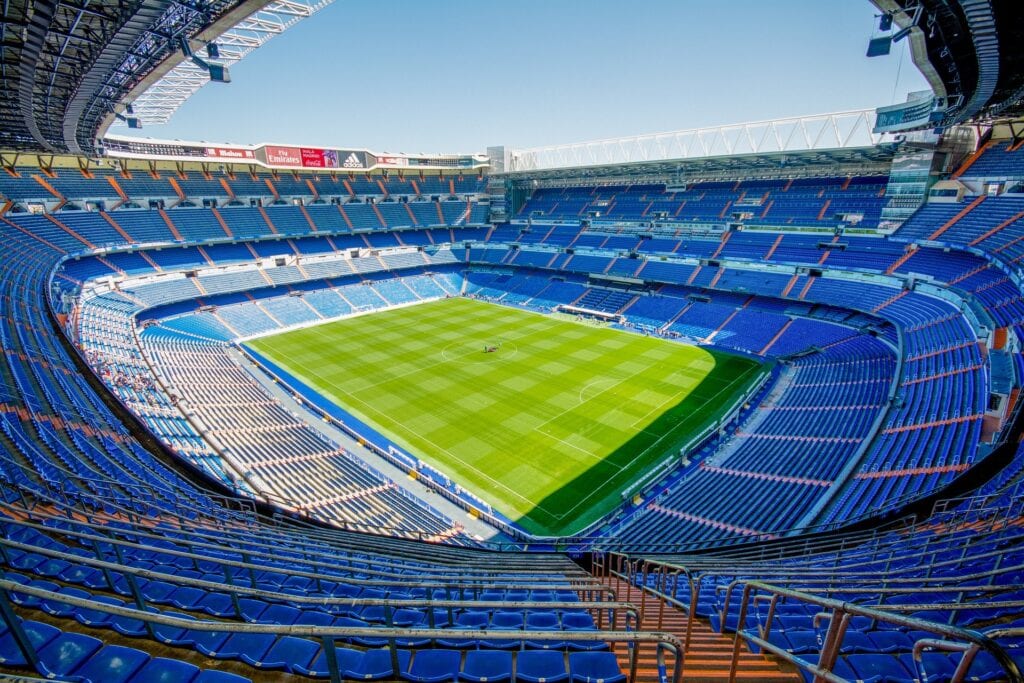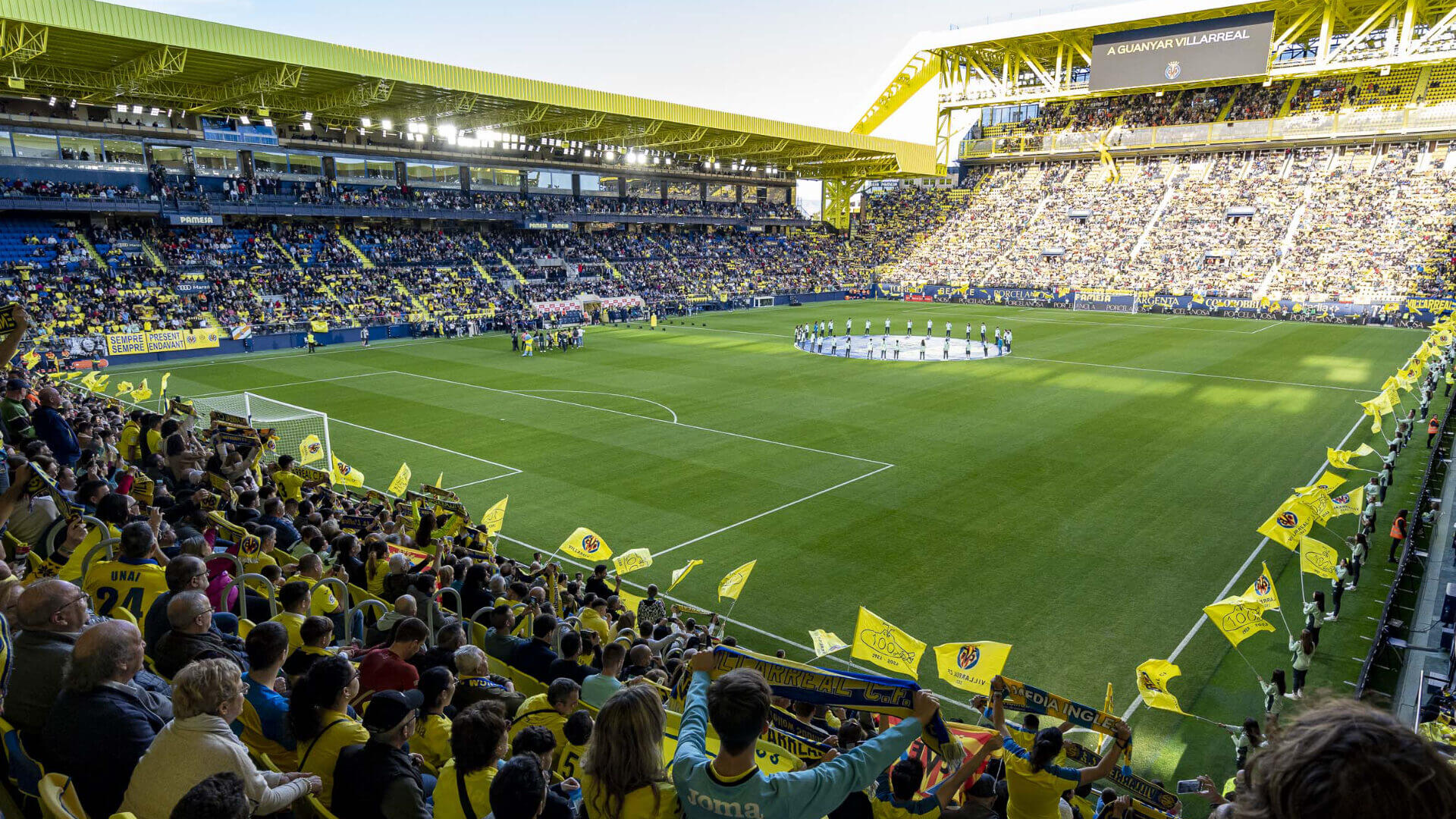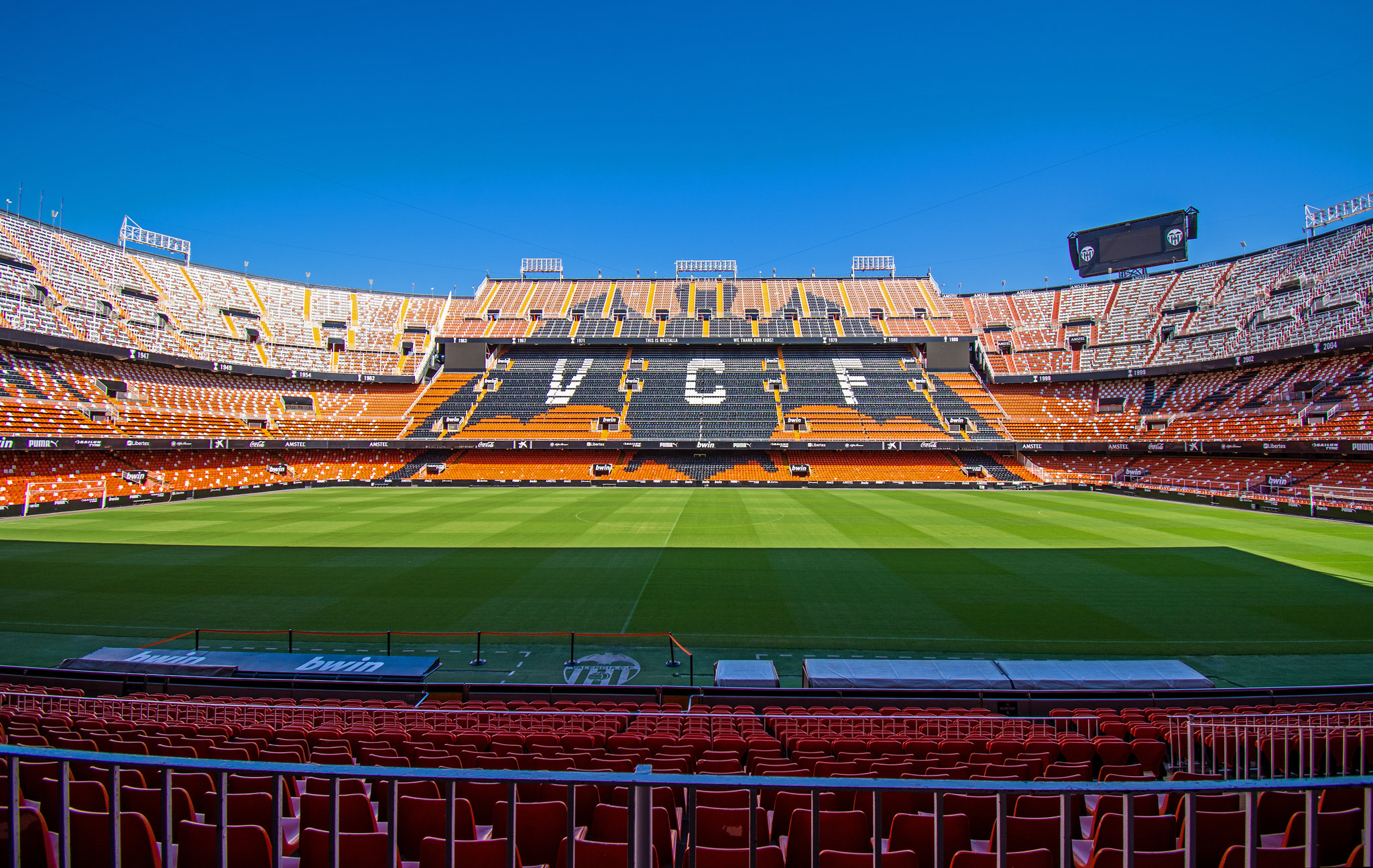A visit to Real Madrid’s Santiago Bernabéu Stadium is high on the bucket list of most European football fans. The iconic home of the thirteen times European champions is one of Madrid’s top tourist sights which attracts fans from all over the world every weekend. As well as reserving a Real Madrid stadium tour, fans can also try to book match tickets before travelling and watch a game at this legendary stadium.
Match tickets are usually available for most La Liga matches although prices for the city derby against Atlético Madrid and El Clásico against FC Barcelona can be astronomical. In this article we’ll provide you with practical advice on travel to Madrid, Real Madrid stadium tours and how to get Real Madrid tickets.

Getting There: Most international travellers arrive at Adolfo Suárez Madrid–Barajas Airport which lies 12km north-east of the Santiago Bernabéu Stadium. On arrival you can quickly travel from all terminals ito Nuevos Ministerios on line 8 of the Metro. This station is just a short walk from the stadium. There are also Renfe Cercanías trains which run from terminal T4 into the city centre and numerous airport bus services. Official taxis are available from all terminals and charge a fixed €30 rate into the city. Check out our Madrid Travel Guide for a comprehenive guide to the Spanish capital.
Where to Stay: If you’re visiting Madrid as part of a general city break then you’d be advised to book a hotel within walking distance of Puerta del Sol rather than near the Bernabéu. This is the heart of the tourist centre which lies 5km south of the stadium. If you’re only in Madrid for a match then you can book some excellent hotels within a short walk of the stadium such as the Holiday Inn Madrid, H10 Tribeca and AC Hotel Aitana.
Santiago Bernabéu Stadium
After Madrid Football Club was founded in 1902 they spent a number of years playing their home matches on a variety of pitches around the city. These included Campo de Jorge Juan next to the old Goya Bullring and the Hipódromo de la Castellana horse racing arena. A growing appetite for the game encouraged the club to look for a larger, more permanent home and in 1912 they moved to Campo de O’Donnell which could accommodate 6,000 fans. In 1920 King Alfonso XIII bestowed royal patronage on the club and they became known as Real Madrid Club de Fútbol.

After a decade at Campo de O’Donnell the club moved to Velódromo de Ciudad Lineal where 8,000 fans were able to watch the team play on grass for the first time. A year later they moved to the 22,500 capacity Estadio de Chamartín which would serve as home to Real Madrid for the next 23 years.

The Estadio de Chamartín suffered extensive damage during the Spanish Civil War (1936-39) and when Santiago Bernabéu was elected president in 1943 he announced plans to build a new stadium. Construction began the following year on land acquired next to the existing stadium and in 1947 the first ever match was played at what was then known as the Nuevo Estadio Chamartín.

It wasn’t until 1955 that it adopted its current name in honour of the club’s president. The original capacity of around 75,000 was increased to 125,000 in the mid-1950s which lasted until the 1980s. It was then reduced to around 90,000 in preparation for the 1982 World Cup when it hosted the final in which Italy beat West Germany.
All Real Madrid’s Stadiums
Various Pitches (1901-12)
Estadio de O’Donnell (1912-23)
Velódromo de Ciudad Lineal (1923-24)
Estadio de Chamartín (1924-47)
Estadio Santiago Bernabéu (1947-Present)
The 1990s saw major redevelopment largely enforced by new safety regulations which resulted in the overall capacity rising to 110,000. This is also when the entrance towers appeared on the four corners of the stadium. Further UEFA rules with regard to all seater stadiums led to the capacity falling at the end of the decade to a little over 75,000.
Following the arrival of Florentino Pérez as club president in 2000 enormous investment went into improving the stadium which not only made for a better spectator experience but also ensured that the club earned the maximum revenue from their facilities. It was during this period of that the club created its museum and started offering Real Madrid stadium tours which have become one of the city’s major tourist attractions.

The current capacity stands at 81,044 which will remain unchanged once current redevelopment is completed. This work will see the Bernabéu transformed into an architectural icon with a retractable roof and moveable pitch.
Real Madrid Stadium Tours and Museum
The self-guided Real Madrid stadium tour is one of the city’s most popular tourist attractions. The visit includes a panoramic view of the Bernabéu from the main stand, entrance into the presidential box, changing rooms, player’s tunnel, benches and coaching area. Visitors can also learn about the illustrious history of Real Madrid in the club museum, approach the playing surface, visit the trophy exhibition and buy merchandise at the official store on the way out.

Opening Times: The Real Madrid stadium tour is available from Mondays to Saturdays from 10am to 7pm. On Sundays and public holidays it opens from 10.30am to 6.30pm. On matchdays the Bernabéu Tour and museum visit is open until 5 hours before kick-off but with limited access. Visitors are strongly advised to plan stadium tours on non-matchdays if possible.
Real Madrid Stadium Tour Tickets: You can buy Bernabéu tour tickets at the museum on the day of your visit. Alternatively you can avoid the queue and pre-order Real Madrid Stadium Tour Tickets which you simply download to your mobile phone. Occasionally there are closed training sessions on the pitch in which case the tour will be closed during its duration. Visitors are informed before buying their entrance tickets.
Getting to the Bernabéu
The Bernabéu is located alongside Paseo de la Castellana, some 5km north of Puerta del Sol which is the city’s tourist centre. Some visitors who in hotels near Puerta del Sol and Gran Via choose to walk up to the ground though be warned it will take you around 45 minutes. Alternatively, you’ll find excellent underground and bus services providing transport to the stadium.
Getting to the Bernabéu by Metro
The football stadium is served by its own metro station. For a direct service you can get on the dark blue line 10 from Plaza de España or Tribunal in the direction of Hospital Infanta Sofía then get off at the Santiago Bernabéu stop. Alternatively, you can get on the light blue line 1 at Atocha or Sol in the direction of Pinar de Chamartín then change to line 10 at Tribunal.

Getting to the Bernabéu by Bus
Buses run up and down Paseo de la Castellana all day and night. Numbers 14, 27, 40, 43, 120, 147 and 150 all stop outside the stadium. Lines 14 and 27 are particularly convenient for many tourists as they depart from Atocha, Paseo del Prado and Plaza de Cibeles.
Getting to the Bernabéu by Train
If you’re staying some distance away or are specifically coming into the city for the match then you should check out the local train network known as the ‘Cercanías’. The nearest train station is at Nuevos Ministerios which is only a 10 minute walk from the ground.
Getting to the Bernabéu by Taxi
Taxis to the stadium are easy to find though there always seems to be a shortage straight after the match so it’s wise to go for a beer in a local bar and let the crowds disappear before looking for one.
Real Madrid Fixtures 2024-25
| Provisional Matchday | Home Team | Away Team | Venue |
|---|---|---|---|
| August 18th | RCD Mallorca | Real Madrid | Estadi Mallorca Son Moix |
| August 25th | Real Madrid | Real Valladolid CF | Estadio Santiago Bernabéu |
| August 29th | UD Las Palmas | Real Madrid | Estadio Gran Canaria |
| September 1st | Real Madrid | Real Betis | Estadio Santiago Bernabéu |
| September 15th | Real Sociedad | Real Madrid | Reale Arena |
| September 22nd | Real Madrid | RCD Espanyol | Estadio Santiago Bernabéu |
| September 25th | Real Madrid | Deportivo Alavés | Estadio Santiago Bernabéu |
| September 29th | Atlético de Madrid | Real Madrid | Civitas Metropolitano |
| October 6th | Real Madrid | Villarreal CF | Estadio Santiago Bernabéu |
| October 20th | Celta Vigo | Real Madrid | Estadio ABANCA Balaídos |
| October 27th | Real Madrid | FC Barcelona | Estadio Santiago Bernabéu |
| November 3rd | Valencia CF | Real Madrid | Camp de Mestalla |
| November 10th | Real Madrid | CA Osasuna | Estadio Santiago Bernabéu |
| November 24th | CD Leganés | Real Madrid | Estadio Municipal Butarque |
| December 1st | Real Madrid | Getafe CF | Estadio Santiago Bernabéu |
| December 8th | Girona FC | Real Madrid | Estadio Municipal de Montilivi |
| December 15th | Rayo Vallecano | Real Madrid | Estadio de Vallecas |
| December 22nd | Real Madrid | Sevilla FC | Estadio Santiago Bernabéu |
| January 12th | Athletic Club | Real Madrid | Estadio San Mamés |
| January 19th | Real Madrid | UD Las Palmas | Estadio Santiago Bernabéu |
| January 26th | Real Valladolid CF | Real Madrid | Estadio Municipal José Zorrilla |
| February 2nd | RCD Espanyol | Real Madrid | RCDE Stadium |
| February 9th | Real Madrid | Atlético de Madrid | Estadio Santiago Bernabéu |
| February 16th | CA Osasuna | Real Madrid | Estadio El Sadar |
| February 23rd | Real Madrid | Girona FC | Estadio Santiago Bernabéu |
| March 2nd | Real Betis | Real Madrid | Estadio Benito Villamarín |
| March 9th | Real Madrid | Rayo Vallecano | Estadio Santiago Bernabéu |
| March 16th | Villarreal CF | Real Madrid | Estadio de la Cerámica |
| March 30th | Real Madrid | CD Leganés | Estadio Santiago Bernabéu |
| April 6th | Real Madrid | Valencia CF | Estadio Santiago Bernabéu |
| April 13th | Deportivo Alavés | Real Madrid | Mendizorroza |
| April 20th | Real Madrid | Athletic Club | Estadio Santiago Bernabéu |
| April 23rd | Getafe CF | Real Madrid | Coliseum |
| May 4th | Real Madrid | Celta Vigo | Estadio Santiago Bernabéu |
| May 11th | FC Barcelona | Real Madrid | Estadi Olímpic Lluís Companys |
| May 14th | Real Madrid | RCD Mallorca | Estadio Santiago Bernabéu |
| May 18th | Sevilla FC | Real Madrid | Ramón Sánchez-Pizjuán |
| May 25th | Real Madrid | Real Sociedad | Estadio Santiago Bernabéu |
You’d be forgiven for assuming that the day and time of Real Madrid games would be published at the start of the season. Unfortunately, that isn’t the case which proves quite inconvenient for fans who are planning a Madrid football break.
Most games take place on Saturday or Sunday at various times and there are quite often Monday night games though these rarely affect Real Madrid. Midweek league fixtures can be from Tuesday to Thursday. The official day and time of kick-offs is usually announced on the Official La Liga Website about 10 days before a match closely followed by a confirmation on the Real Madrid website.
Champions League games are always at 8.45pm Madrid time on a Tuesday or Wednesday and are confirmed well in advance.
How to Get Real Madrid Tickets
Internet Sales: Match tickets can be purchased online through the official Real Madrid website. Online ticket sales can be collected from the ticket office at the stadium or downloaded as an e-ticket to your mobile phone.
Ticket Office: For most matches you can buy tickets at the Santiago Bernabéu ticket booths (‘taquillas’) next to gate 42 of the stadium on Calle Concha Espina. This ticket office is usually open from 9 am to 7 pm in the days leading up to the game. Matches against FC Barcelona and Atlético de Madrid usually sell out as do Champions League games against Europe’s elite clubs. For those matches you’ll most likely need to find out what’s on offer on secondary ticket websites such as Viagogo.
Bernabéu Stadium Seating Map
The following seating plan should help you out when ordering Real Madrid tickets online:




